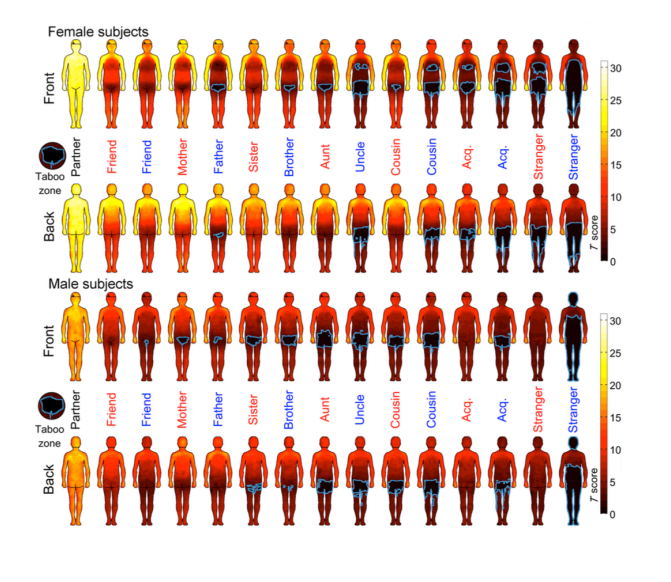Touching is an essential part of any relationship. Handshakes, pats on the back and kisses on the lips -- a touch can mean a lot. But some touching isn't quite so welcome, as you can plainly see in new "body maps."
Researchers from Aalto University in Finland and the University of Oxford in England published body maps that show exactly where men and women from different cultures allow touches by friends, family, extended family and strangers. The findings were released last week in the Proceedings of the National Academy of Sciences.
"The bodily maps that show where different people are allowed to touch were strongly linked to who the toucher was and were remarkably similar across the cultures," Juulia Suvilehto, a doctoral candidate at Aalto University and the lead author of a paper about the research, told The Huffington Post in an email.
Suvilehto was surprised to see that touching norms were the same between cultures, but the evidence was clear.
"The differences between cultures are smaller than the differences between different layers of social network (social groups you are a member of, such as family, extended family, friends) and actually the touch area maps of different social groups are very similar across cultures," she said.
To complete her research, Suvilehto and her colleagues asked a total of 1,368 people from Finland, France, Russia, Italy and the United Kingdom to look at the body map online and indicate those parts of their body that they would allow relatives, friends and strangers to touch.

The images above represent the compiled responses from female subjects (top), and male subjects (bottom). The body maps show where the subject would let a partner, female friend, male friend and so on touch them.
The gender of the toucher is indicated by color -- the word cousin in red means a female cousin, and in blue means a male cousin.
Yellow means touching is OK, and darker colors mean touching is not. Areas of black outlined in blue indicate areas that are taboo to touch.
Some of the chart might not surprise you. The map suggests that when it comes to touching, relationship dictates all. Our partners have full access to our bodies, but we're way less interested in being handled by a stranger.
But these charts do tell us something interesting: Women seem more OK with being touched than men. And men are more OK with a woman touching them than a man.
"We do not know what the reason for the gender difference is, but a lot of earlier research points in the same direction," Suvilehto said. "One possible explanation is that it is somehow culturally more appropriate for women to touch and be touched than men."
Suvilehto hopes to continue research by using real-time touch-tracking with subjects in the future. But for now, she is working on another similar study that relies on self-reporting -- and you can actually join in and become a participant here.
